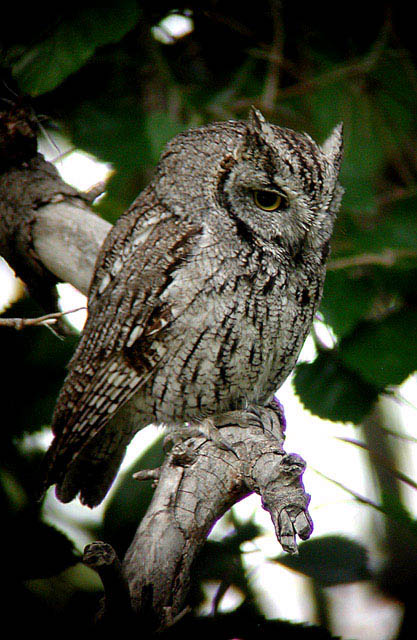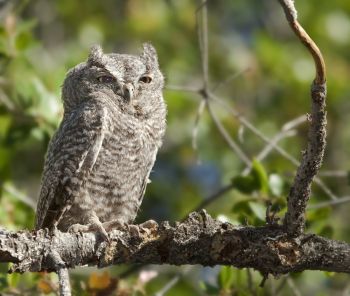m |
|||
| (11 intermediate revisions by 6 users not shown) | |||
| Line 1: | Line 1: | ||
| − | + | [[Image:Western_Screech_Owl.jpg|thumb|550px|right|Photo by {{user|oldsquaw|oldsquaw}}<br />Pueblo, [[Colorado]]]] | |
| − | [[Image:Western_Screech_Owl.jpg|thumb|550px|right|Photo by oldsquaw | + | ;[[:Category:Megascops|Megascops]] kennicottii |
| − | + | ''Otus kennicottii'' | |
==Identification== | ==Identification== | ||
| − | Brown or dark grey plumage | + | *Brown or dark grey plumage |
| + | *Streaked underparts | ||
| + | *Round head with ear tufts | ||
| + | *Yellow eyes | ||
| + | *Yellowish bill. | ||
==Distribution== | ==Distribution== | ||
| − | [[Alaska]] and north-western [[Canada]] to [[California]]. | + | [[File:Western_Screech_Owl_Mk-bendirei_JMOR.jpg|thumb|350px|right|Subspecies '' M. k. bendirei''<br />Photo © by {{user|jmorlan|Joseph Morlan}}<br />Briones Regional Park, Martinez, [[California]], [[USA]], 28 May 2021]] |
| + | [[Alaska]] and north-western [[Canada]] to [[California]] and [[Mexico]]. | ||
==Taxonomy== | ==Taxonomy== | ||
| − | This and almost all Screech Owls in the Americas have previously been considered to belong in the same genus (''Otus'') as the European and Asian Scops-Owls, but a reassignment to Megascops | + | This and almost all Screech-Owls in the Americas have previously been considered to belong in the same genus (''Otus'') as the European and Asian Scops-Owls, but a reassignment to ''Megascops'' has been accepted by among other authorities, the American Ornithologists' Union. |
| + | [[File:Western_screech_owl_fledgeling_by_digishooter.jpg|thumb|350px|right|Fledgeling<br />Photo © by {{user|digishooter|digishooter}}<br />Keysville: Kern Co., [[California]], [[USA]], May 2011]] | ||
| + | A study showing strong genetic structure may indicate a possible future split. | ||
| + | ====Subspecies<sup>[[#References|[1]]]</sup>==== | ||
| + | *''M. k. kennicottii'': | ||
| + | :*Coastal southeastern [[Alaska]] to north-western [[Canada]] and southern [[Oregon]] | ||
| + | *''M. k. macfarlanei'' | ||
| + | :*Southern British Columbia south to eastern [[Oregon]], [[Idaho]], and western [[Montana]] | ||
| + | *''M. k. bendirei'': | ||
| + | :*Pacific coast of [[North America]] from south central [[Oregon]] south through [[California]] (west of the Sierra Nevada) to northwestern [[Mexico]] (coastal northern [[Baja California]]) | ||
| + | *''M. k. aikeni'': | ||
| + | :*South-western [[US]]: [[California]] east of the Sierra Nevada and [[Nevada]] east to [[Colorado]] and west [[Texas]] | ||
| + | *''M. k. cardonensis'': | ||
| + | :*Northern [[Baja California]] | ||
| + | *''M. k. xantusi'': | ||
| + | :*Cape district of southern [[Baja California]] | ||
| + | *''M. k. yumanensis'': | ||
| + | :*South-eastern [[California]] and south-western [[Arizona]] to northern [[Mexico]] (north-western Sonora) | ||
| + | *''M. k. vinaceus'': | ||
| + | :*Northern [[Mexico]] (southern Sonora and western Chihuahua to northern Sinaloa) | ||
| + | *''M. k. suttoni'': | ||
| + | :*South-western [[Texas]] to [[Mexico|Mexican]] Plateau | ||
==Habitat== | ==Habitat== | ||
Open deciduous or mixed woods. | Open deciduous or mixed woods. | ||
==Behaviour== | ==Behaviour== | ||
| + | They are active during the night or as dusk approaches. | ||
| + | ====Breeding==== | ||
They nest in a cavity in a tree or cactus, often using old woodpecker holes. | They nest in a cavity in a tree or cactus, often using old woodpecker holes. | ||
| − | + | ====Diet==== | |
| − | They wait on a perch and swoop down on prey; they may also catch insects in flight. The diet includes small mammals and large insects, also small birds. | + | They wait on a perch and swoop down on prey; they may also catch insects in flight. The diet includes small mammals and large insects, also small birds. |
| − | + | ==References== | |
| + | #{{Ref-Clements6thAug21}}#[http://www.barcodeoflife.org/barcode/batsbirds/literature/MEN1670_final.pdf Paper] describing genetic findings with this species | ||
| + | {{ref}} | ||
==External Links== | ==External Links== | ||
| − | {{GSearch| | + | {{GSearch|Screech+kennicott*}} |
| + | {{GS-checked}}<br /><br /> | ||
| − | [[Category:Birds]] | + | [[Category:Birds]][[Category:Megascops]] |
Latest revision as of 04:55, 2 July 2022
- Megascops kennicottii
Otus kennicottii
Identification
- Brown or dark grey plumage
- Streaked underparts
- Round head with ear tufts
- Yellow eyes
- Yellowish bill.
Distribution

Photo © by Joseph Morlan
Briones Regional Park, Martinez, California, USA, 28 May 2021
Alaska and north-western Canada to California and Mexico.
Taxonomy
This and almost all Screech-Owls in the Americas have previously been considered to belong in the same genus (Otus) as the European and Asian Scops-Owls, but a reassignment to Megascops has been accepted by among other authorities, the American Ornithologists' Union.
A study showing strong genetic structure may indicate a possible future split.
Subspecies[1]
- M. k. kennicottii:
- M. k. macfarlanei
- M. k. bendirei:
- Pacific coast of North America from south central Oregon south through California (west of the Sierra Nevada) to northwestern Mexico (coastal northern Baja California)
- M. k. aikeni:
- South-western US: California east of the Sierra Nevada and Nevada east to Colorado and west Texas
- M. k. cardonensis:
- Northern Baja California
- M. k. xantusi:
- Cape district of southern Baja California
- M. k. yumanensis:
- South-eastern California and south-western Arizona to northern Mexico (north-western Sonora)
- M. k. vinaceus:
- Northern Mexico (southern Sonora and western Chihuahua to northern Sinaloa)
- M. k. suttoni:
Habitat
Open deciduous or mixed woods.
Behaviour
They are active during the night or as dusk approaches.
Breeding
They nest in a cavity in a tree or cactus, often using old woodpecker holes.
Diet
They wait on a perch and swoop down on prey; they may also catch insects in flight. The diet includes small mammals and large insects, also small birds.
References
- Clements, J. F., T. S. Schulenberg, M. J. Iliff, S. M. Billerman, T. A. Fredericks, J. A. Gerbracht, D. Lepage, B. L. Sullivan, and C. L. Wood. 2021. The eBird/Clements checklist of Birds of the World: v2021. Downloaded from https://www.birds.cornell.edu/clementschecklist/download/
- Paper describing genetic findings with this species
Recommended Citation
- BirdForum Opus contributors. (2024) Western Screech-Owl. In: BirdForum, the forum for wild birds and birding. Retrieved 12 May 2024 from https://www.birdforum.net/opus/Western_Screech-Owl
External Links
GSearch checked for 2020 platform.





